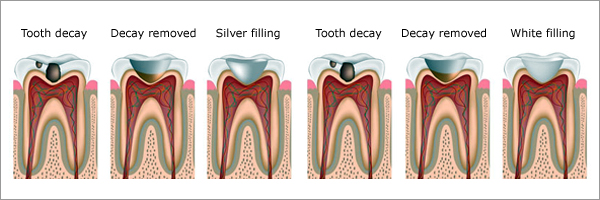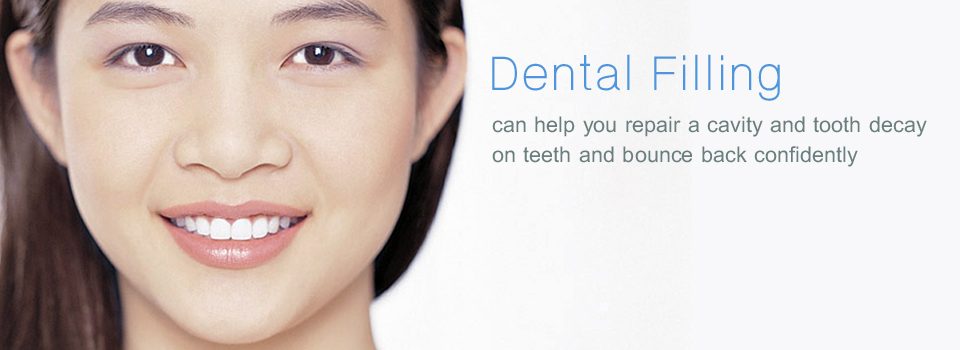Filling
A tooth filling is necessary when a tooth has a cavity in it. Once the tooth has a cavity, it is recommended to get a filling as soon as possible, before the cavity grows and further damages the tooth.
The dentist will usually drill around the cavity slightly to get rid of any damaged tooth, before applying the filling. Depending on how deep the cavity is, the dentist may or may not use local anesthetic.
The most commonly used filling materials are amalgam and composite. Amalgam (silver) fillings are stronger. They are made from liquid mercury mixed with a powdered alloy of silver, copper, and tin. These are sometimes used for fillings that are hidden, but for visible fillings many people prefer to have tooth-colored composite resin fillings.

If a cavity is very big, the pulp and roots may be infected and in this case, root canal treatment might be needed. For large cavities, the dentist may recommend an inlay or onlay. Some people avoid amalgam fillings due to the mercury content, which releases low levels of vapor, however the Food and Drug Administration (FDA) state that the levels are very low, and not known to cause harm.
It is very rare to have complications from a dental filling, however, there is a risk that the filling will come out, and the procedure will need repeating. There is also a very small risk of nerve damage or infection, as well as injuries to the lip and gums as a result of local anesthetic, meaning that patients don’t detect pain. Some patients may have an allergic reaction to materials used.
Recommended for: Cavities
BEFORE TOOTH FILLING ABROAD
Depending on the location and the severity of the cavity, your dentist may administer a local anesthetic to the area before performing the filling, although increasingly many fillings are carried out painlessly without it.
While most patients are unlikely to need it, for longer procedures, a dentist might also use a bite block to prop the mouth open for the duration of the procedure.
HOW IS IT PERFORMED
If the mouth has been numbed, the dentist will allow the anesthesia to take effect before beginning the process of removing the decayed parts of the tooth, most commonly with a high speed dental drill.
Depending on the location of the cavity and the material of the filling, a few things can happen next. For most patients it is simply a matter of covering the cavity hole with the appropriate material. Once applied, the dentist will shape the filling so that it feels natural to the patient and doesn’t affect their natural bite. For patients receiving composite fillings, it is normal for the filling to be set with LED lights.
For patients receiving a filling between two teeth, things are a little more involved. The dentist will place a metal band around the tooth to build the wall of the tooth up. The dentist will additionally place a dividing wedge between the two teeth so that once the filling is completed, the neighboring tooth and the new filling will touch and prevent food from getting caught between the two teeth when you chew.
Anesthesia : Fillings can be done without any anesthetic, or with local anesthetic.
Procedure duration : The Tooth Filling takes 30 to 60 minutes.
WHAT TO EXPECT AFTER TOOTH FILLING
Post procedure care : Patients should avoid eating on the filling straight away as it might come out. After local anesthetic, it is advised to avoid hot food and drinks while the mouth is numb to avoid the risk of burning.
Possible discomfort : Most patients do not experience any discomfort following a filling, although some sensitivity on the treated tooth is normal.
IMPORTANT THINGS TO KNOW ABOUT TOOTH FILLING Not recommended for
• Large cavities
• Patients with allergies to mercury (amalgam filling) Potential risks
• Filling may fall out
• Never damage
• Infection
• Damage to the lips or gums
• Allergic reaction to materials used






